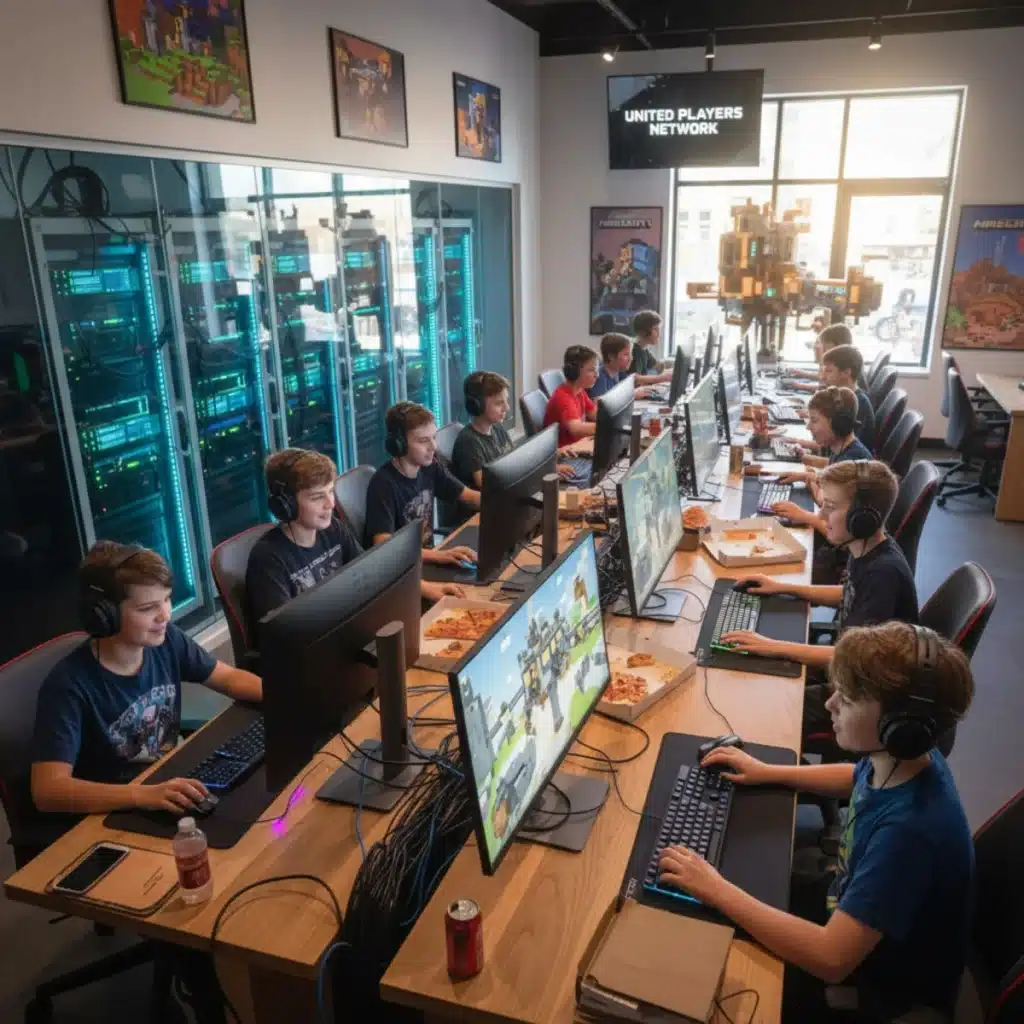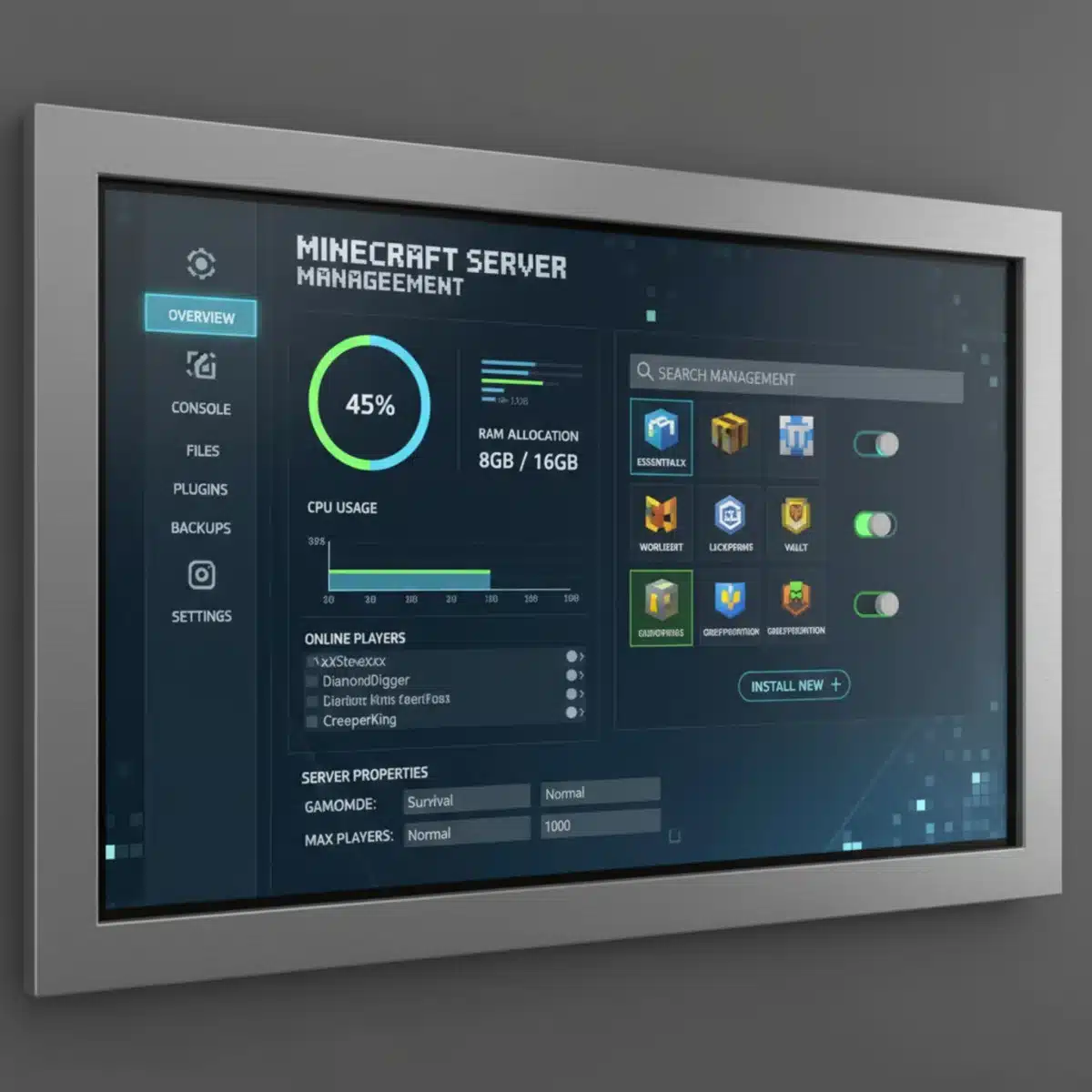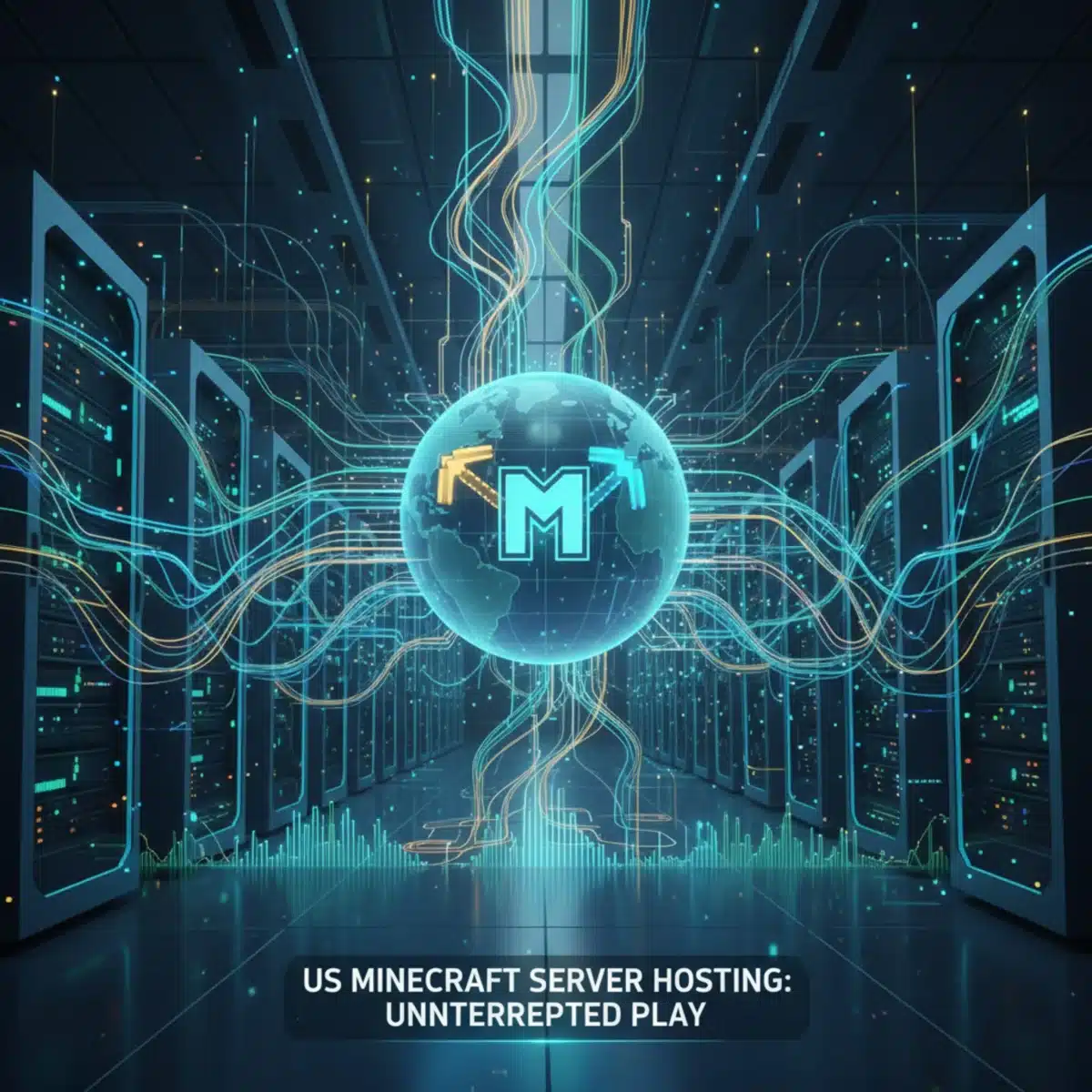Minecraft Server Hosting: Best Options for US Players in 2025

Advertisements
Choosing the best Minecraft server hosting for US players in 2025 involves evaluating performance, reliability, features, and cost to ensure an optimal multiplayer gaming experience with minimal latency.
Are you a dedicated Minecraft player in the United States looking to elevate your multiplayer experience? Finding the ideal Minecraft Server Hosting: Choosing the Best Option for US Players in 2025 is crucial for smooth gameplay, minimal lag, and a truly immersive world for you and your friends. This guide will walk you through everything you need to know to make an informed decision, ensuring your next adventure in blocky realms is nothing short of epic.
Anúncios
Understanding Minecraft Server Hosting Essentials
Before diving into specific providers, it’s essential to grasp the fundamental elements that define excellent Minecraft server hosting. These core components directly impact your gameplay experience, from how quickly your world loads to how many players can join simultaneously without performance issues. Understanding these factors will empower you to compare options more effectively and choose a host that aligns with your specific needs and expectations for 2025.
The landscape of server hosting is constantly evolving, with new technologies and services emerging regularly. For US players, proximity to data centers and robust network infrastructure are particularly vital to minimize latency. Beyond the technical specifications, customer support and ease of use also play significant roles in the overall hosting experience.
Anúncios
Key technical specifications to consider
When evaluating hosting providers, several technical specifications stand out as non-negotiable for a superior Minecraft experience. These include RAM, CPU, storage type, and network bandwidth. Each plays a distinct role in how your server performs under different loads and with various modifications.
- RAM (Random Access Memory): This is perhaps the most critical factor. More RAM allows for more players, larger worlds, and more complex mods or plugins. For a small group, 2-4GB might suffice, but larger communities or heavily modded servers will demand 8GB or more.
- CPU (Central Processing Unit): A powerful CPU is essential for handling the game’s physics, mob AI, and chunk generation. Look for hosts offering modern, high-clock-speed processors, as Minecraft largely benefits from strong single-core performance.
- Storage Type (SSD vs. HDD): Solid State Drives (SSDs) offer significantly faster read/write speeds than traditional Hard Disk Drives (HDDs). This translates to quicker world loading, faster server restarts, and reduced lag, making SSDs a must-have for optimal performance.
- Network Bandwidth: High bandwidth ensures smooth data transfer between your players and the server. US players should prioritize hosts with excellent network infrastructure and peering agreements to minimize ping and packet loss across the country.
Beyond these, consider the operating system the server runs on and whether it supports specific server versions (e.g., Spigot, PaperMC, Forge) you might want to use. A host that offers flexibility in these areas provides a more future-proof solution for your evolving Minecraft adventures.
Performance and Reliability for US Players
For US players, performance and reliability are paramount. The vast geographic expanse of the United States means that server location, network infrastructure, and uptime guarantees are critical factors in minimizing latency and ensuring a consistent gaming experience. A server located on the opposite coast could introduce noticeable lag, even with a strong internet connection.
Reliability also extends to the stability of the server hardware and the provider’s ability to handle unexpected issues. Downtime is frustrating, especially when you’ve invested time and effort into your world. Therefore, robust infrastructure and proactive monitoring are key indicators of a trustworthy hosting service.
Server locations and latency
When selecting a host, investigate their data center locations. For US players, having servers strategically placed across the country (e.g., East Coast, Central, West Coast) is highly beneficial. Choose a data center geographically closest to the majority of your player base to ensure the lowest possible ping times. Many reputable hosts will allow you to select your preferred server location during setup.
Lower latency means a more responsive game, fewer rubber-banding incidents, and a generally more enjoyable experience for everyone involved. Some hosts even provide tools to test latency to their various data centers before you commit, which is a valuable feature to look for.
Uptime guarantees and support
A host’s uptime guarantee reflects their confidence in their infrastructure. Look for providers offering 99.9% uptime or higher. While 100% uptime is virtually impossible, a strong guarantee indicates a commitment to keeping your server running. Alongside this, evaluate their customer support. Is it available 24/7? Do they offer multiple contact methods (live chat, tickets, phone)? Responsive and knowledgeable support can be a lifesaver when technical issues arise.
The best providers for Minecraft Server Hosting: Choosing the Best Option for US Players in 2025 will not only promise high uptime but also demonstrate a track record of consistent reliability and a support team that can quickly resolve problems, minimizing disruption to your game.
Essential Features for a Modern Minecraft Server
Beyond raw performance, the features offered by a hosting provider can significantly enhance your Minecraft server experience. These features range from user-friendly control panels to advanced security measures and backup options, all designed to make managing your server easier and more secure. As Minecraft continues to evolve, so too do the expectations for server functionality.
Consider what kind of server you envision. Will it be a vanilla survival world, a complex modded server, or a mini-game hub? Your choice of host should support these ambitions with the right set of tools and capabilities. A feature-rich host can save you a lot of time and effort in the long run.
User-friendly control panels and mod support
A good control panel, such as a customized Pterodactyl or Multicraft interface, simplifies server management. You should be able to easily start/stop your server, manage files, install plugins/mods, and configure settings without needing extensive technical knowledge. The best control panels offer one-click installations for popular mod packs and server types.
Mod support is paramount for many players. Ensure the host allows easy installation of Forge, Fabric, Spigot, Paper, or other server software. Some hosts even offer pre-configured mod packs, streamlining the setup process for complex modded experiences.
Automated backups and DDoS protection
Losing your Minecraft world due to a server crash or accidental deletion is devastating. Therefore, automated daily backups are a non-negotiable feature. Look for hosts that store backups off-site and provide easy restoration options. This provides peace of mind, knowing your hard work is protected.
DDoS (Distributed Denial of Service) attacks can bring a server down, disrupting gameplay. Robust DDoS protection is crucial, especially for public servers. Reputable hosts will offer enterprise-grade protection to mitigate these attacks, ensuring your server remains online and accessible to players even under threat. This is a critical security consideration for any serious Minecraft server owner.

Pricing and Value for Money for US Players
While performance and features are vital, the cost of hosting is often a significant deciding factor. For US players, evaluating pricing means looking beyond the monthly fee and considering the overall value offered. This includes understanding hidden costs, promotional rates, and what exactly is included in each package. A cheaper plan might seem appealing, but if it lacks essential features or compromises on performance, it could lead to frustration in the long run.
The goal is to find a balance between affordability and the quality of service. Remember that hosting is an investment in your gaming experience, so it’s worth allocating a reasonable budget to ensure a smooth and enjoyable server for everyone.
Understanding different pricing tiers
Most Minecraft server hosts offer tiered pricing based on allocated RAM, CPU cores, and storage. Understand what each tier provides and how it aligns with your expected player count and mod usage. Don’t overpay for resources you won’t use, but also don’t under-provision, which can lead to lag and a poor experience.
- Entry-level plans: Typically 1-4GB RAM, suitable for small private servers (2-10 players) with light modding.
- Mid-tier plans: 4-8GB RAM, ideal for medium-sized communities (10-30 players) or moderately modded servers.
- High-end plans: 8GB+ RAM, necessary for large public servers, heavily modded instances, or mini-game networks.
Always check if there are any hidden fees or extra charges for features like dedicated IP addresses, backups, or specific mod installations. Transparency in pricing is a hallmark of a reputable provider.
Free trials and money-back guarantees
Many hosts offer free trials, allowing you to test their service before committing. This is an excellent opportunity to evaluate performance, ease of use, and customer support. If a free trial isn’t available, look for a money-back guarantee. A 24-hour to 7-day money-back window provides enough time to ensure the service meets your expectations without financial risk. This allows you to confidently explore Minecraft Server Hosting: Choosing the Best Option for US Players in 2025.
These offers demonstrate a host’s confidence in their service and provide a safety net for new customers. They are particularly useful for US players who want to test latency and overall server responsiveness from their specific location before making a long-term commitment.
Top Minecraft Server Hosting Providers for US Players in 2025
With numerous providers vying for your business, it can be challenging to narrow down the best options. This section highlights some of the leading Minecraft server hosting providers that consistently receive high marks for performance, features, and customer satisfaction, particularly for US players. Each has its strengths, catering to different types of server owners and budgets.
When reviewing these providers, consider your specific needs: are you building a small private server for friends, or a large public community? Do you plan to run complex mod packs, or stick to vanilla Minecraft? These considerations will help you determine which host is the best fit for your unique vision.
Provider A: Focus on performance and low latency
Provider A is renowned for its robust infrastructure and multiple data centers strategically located across the US. They prioritize low latency and high performance, making them an excellent choice for competitive play or large communities where every millisecond counts. Their plans often feature high-clock-speed CPUs and ample SSD storage.
They typically offer advanced DDoS protection and full root access on higher-tier plans, giving experienced users maximum control. While their pricing might be slightly higher than some budget options, the investment often translates to a significantly smoother and more reliable gaming experience for US players.
Provider B: Balancing features and affordability
Provider B strikes a commendable balance between comprehensive features and competitive pricing. They offer user-friendly control panels, one-click mod pack installations, and automated backups as standard across most plans. Their data centers are well-distributed within the US, ensuring good connectivity for a wide audience.
This provider is often recommended for those new to server hosting or players who want a hassle-free setup without breaking the bank. They provide solid performance for a reasonable cost, making them a popular choice for small to medium-sized Minecraft communities looking for reliable Minecraft Server Hosting: Choosing the Best Option for US Players in 2025.
Provider C: Premium options for large communities
For large-scale public servers, mini-game networks, or heavily modded instances, Provider C offers premium solutions. They specialize in high-resource plans, often featuring dedicated CPU cores and scalable RAM options up to 32GB or more. Their infrastructure is built to handle thousands of concurrent players with minimal performance degradation.
While their services come at a higher price point, they deliver unparalleled stability and support for demanding server environments. They frequently offer advanced customization options and expert technical support, making them ideal for server owners with ambitious projects and a budget to match.

Setting Up Your Minecraft Server: A Step-by-Step Guide
Once you’ve chosen your ideal Minecraft server host, the next exciting step is setting up your server. While each provider has its own control panel and specific procedures, the general steps remain largely consistent. This guide provides a universal overview to help you get your Minecraft world online and ready for players, focusing on aspects relevant to US players and optimal configuration.
Don’t be intimidated by the process; modern hosting panels are designed for ease of use. Even if you’re new to server administration, following these steps will help you launch your server successfully and efficiently.
Choosing your server type and version
The first decision is your server type. Will it be vanilla Minecraft, or a modified version? Popular choices include:
- Vanilla: The pure Minecraft experience, directly from Mojang. Simple to set up.
- Spigot/PaperMC: Optimized for performance and allows plugins. Essential for public servers.
- Forge/Fabric: For installing mods that change gameplay, add new items, or alter world generation.
Select the Minecraft version that all your players will use. Most control panels offer one-click installation for these server types and versions. Ensure your chosen host supports the specific server software you intend to use.
Configuring server settings and plugins/mods
After installation, you’ll access your server’s control panel to configure various settings. This includes:
- Server Name: What your server will be called in the multiplayer list.
- Difficulty: Peaceful, Easy, Normal, Hard.
- Game Mode: Survival, Creative, Adventure, Spectator.
- Whitelist: Allows only specific players to join. Recommended for private servers.
- Max Players: Adjust based on your plan’s resources.
If you’re using Spigot/Paper, you can upload and install plugins to add features like land protection, economy systems, or mini-games. For Forge/Fabric, you’ll upload your desired mods to the server’s mod folder, ensuring all players have the same mod setup on their clients.
Remember to regularly back up your server files, especially before making significant changes or installing new mods. This proactive approach ensures you can always revert to a stable state if something goes wrong during configuration.
Optimizing Your Minecraft Server for US Audiences
Once your server is up and running, optimization becomes key to providing the best possible experience for your US players. This involves fine-tuning server settings, managing resources efficiently, and staying updated with best practices. A well-optimized server runs smoothly, reduces lag, and keeps players engaged, regardless of their location within the United States.
Optimization is an ongoing process, not a one-time task. As your player base grows or you add new content, you’ll likely need to revisit these settings to maintain peak performance. Consistent monitoring and adjustments are crucial for long-term success.
Reducing lag and improving player experience
Lag is the bane of any Minecraft server. To combat it, consider these strategies:
- Limit loaded chunks: Reduce the server’s view distance in
server.properties. A lower value means less for the server to process. - Manage entities: Too many entities (mobs, items dropped) can cause lag. Plugins can help despawn unused items or limit mob spawns.
- Optimize plugins/mods: Some plugins or mods are more resource-intensive than others. Regularly review their impact and remove any that cause significant performance drops.
- Scheduled restarts: Regular server restarts (e.g., daily) can clear memory leaks and refresh the server’s state, improving long-term stability.
Encourage players to use performance-enhancing client-side mods like OptiFine or Sodium, which can significantly improve their framerates without impacting server performance directly.
Community management and growth for US players
A thriving community is the heart of any successful Minecraft server. For US players, fostering a welcoming and engaging environment is crucial. Establish clear rules, enforce them fairly, and provide channels for communication, such as a Discord server.
Regular events, new content updates, and active moderation can keep players engaged. Consider hosting themed builds, mini-game tournaments, or community challenges. Promoting your server through forums, social media, and word-of-mouth within the US Minecraft community can help attract new players and grow your world. Remember that a server is only as good as the community it fosters, and active engagement is key to its longevity and enjoyment.
| Key Aspect | Brief Description |
|---|---|
| Performance Metrics | Focus on RAM, CPU, SSD storage for optimal speed and lag reduction. |
| US Server Locations | Choose hosts with data centers near your player base for minimal latency. |
| Essential Features | Look for user-friendly control panels, mod support, automated backups, and DDoS protection. |
| Value and Support | Assess pricing tiers, uptime guarantees, and 24/7 customer support for overall value. |
Frequently asked questions about Minecraft server hosting
For a small private server (5-10 players) with light mods, 4GB of RAM is usually sufficient. Larger servers with many players or extensive mod packs might require 8GB or more to ensure smooth performance and prevent lag across the United States.
The server’s physical location relative to your players is the most crucial factor for low latency. Choosing a data center geographically closest to the majority of your US player base will significantly reduce ping times and improve connection quality.
Always opt for SSD (Solid State Drive) storage. SSDs offer significantly faster read/write speeds compared to HDDs, leading to quicker world loading, faster server restarts, and overall better performance, which is essential for a smooth Minecraft experience.
Yes, DDoS protection is highly recommended, especially for public servers. It safeguards your server from malicious attacks that can cause downtime and disrupt gameplay, ensuring your server remains accessible and stable for your community.
Most reputable Minecraft server hosts support mods and plugins, but it’s essential to verify. Look for hosts that offer easy installation of server types like Spigot, PaperMC, Forge, or Fabric, as these are necessary to run custom content effectively.
Conclusion
Navigating the world of Minecraft Server Hosting: Choosing the Best Option for US Players in 2025 requires careful consideration of various factors, from technical specifications and performance to pricing and customer support. For US players, prioritizing hosts with strategically located data centers and robust network infrastructure is paramount to minimizing latency and ensuring a smooth, enjoyable gaming experience. By understanding the essentials, evaluating key features like user-friendly control panels and automated backups, and comparing reputable providers, you can confidently select a hosting solution that meets your specific needs and helps you build the Minecraft world of your dreams. The right host will not only provide a stable platform but also empower you to foster a vibrant and engaged community, making your Minecraft adventures truly unforgettable.





